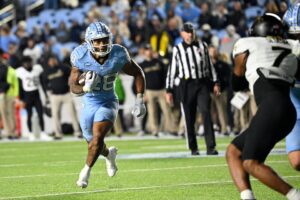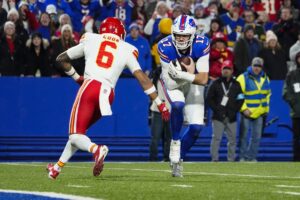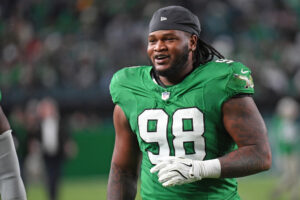Welcome to the biggest dog and pony show of the year. The NFL Combine is a great opportunity for running backs and all positions to show off their elite physical traits. While seeing the fast people run fast is exciting, an under rated storyline is the thresholds each player needs to meet to secure good draft capital. There have been 30 running backs selected with top 100 picks in the last five drafts. With that in mind, what are the minimum thresholds for the running backs at the 2024 NFL Combine?
Key Measurements for Running Backs at the NFL Combine
40 Yard Dash
Of the 30 running backs drafted in this range, only three have run a 4.6 or slower. Clyde Edwards-Helaire, Zach Moss and Devin Singletary. It’s noteworthy that the two slowest were selected by the same team in back-to-back drafts. Over two thirds of the players had 40s 4.55 seconds or faster. So, the soft line is 4.55, with a firmer line drawn at 4.6 with some funny exceptions in hindsight.
Film Study on Running Back Likely to Crush the 40
Vertical Jump
The vertical jump has a different meaning for running backs than for wide receivers. Wide receivers need to be explosive off the line, but their vertical is also important in high pointing the ball. For running backs, it’s just a measure of explosiveness. In the wide receiver thresholds piece, Chris Olave was an outlier with the lowest vertical at 32 inches. 32 inches would be only slightly below average for running backs. The average vertical of a top 100 running back is two inches shorter than a first-round wide receiver, and Brian Robinson and Tyrion Davis-Price bottom out the list. Their 30-inch totals are the hard line for running backs.
Running Back With Most to Gain at NFL Combine
Broad Jump
Another metric for explosiveness, the broad jump has a line in the sand set at 115 inches. Tyrion Davis-Price and Devin Singletary were the lowest at 117 inches each. This isn’t meant to be a time to look at clear misses, but for a system predicated on speed and space, TDP didn’t seem like a fit in San Francisco. Travis Etienne posted the highest broad jump at 128 inches for anyone curious.
Agility Drills
Of the 30 running backs selected with a top 100 pick, only five conducted the 3 cone. This isn’t enough data to make meaningful conclusions among 30 prospects, but for what it’s worth Devin Singletary had the slowest drill. The short shuttle had a similarly low participation rate, but Cam Akers and Devin Singletary posted the two slowest at 4.42 and 4.4 seconds.
Running Back Who Will Dominate Agility Events if He Participates
Last Word on Running Back Thresholds at the NFL Combine
There isn’t a correlation between many of these metrics and NFL production. But there is a correlation between the thresholds here and the draft capital spent. When we try to find out why consensus top backs fall in the draft, bad combine performances are one of the explanations. If a running back wants top 100 draft capital, they should:
- Run faster than a 4.6 40 yard dash
- Jump higher than 30 inches in the vertical
- Jump further than 115 inches in the broad jump
- Skip the agility drills
More running backs opted to conduct the bench press than wide receivers, and a big shout out to J.K. Dobbins who showed up, benched 225 23 times, didn’t do any other events and then dipped out.
Main Photo Credit: Syndication: The Columbus Dispatch






